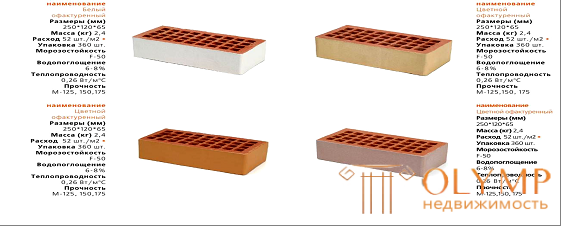
The use of bricks in construction. Clay is one of the oldest building materials in the world. The history of its development by man has several millennia. The most ancient items of baked clay found in the parking lot of the Paleolithic in Slovakia. Their age is 25 thousand years. The term "ceramics" refers to products made of baked clay, and brick was and remains the most important product of pottery.
The use of baked bricks in construction also dates back to ancient times. This is evidenced by Egyptian buildings belonging to the III-II thousand. BC. e. An important role was played by bricks in the architecture of Mesopotamia and Ancient Rome, where complex structures were laid out of bricks: arches, arches, etc. In the central Chinese province of Hunan, during excavations of the graves of the Eastern Han dynasty (AD 25-220), archaeologists discovered an ancient brick, on the surface of which the inscription was visible: “Buy my bricks. They will bring happiness and are not expensive at all. ”
The first brick building in ancient Russia was the Tithe Church in Kiev. In Moscow, the first brick houses were built in 1450. And in 1475 the first brick factory in Russia was built. Before that, brick production was mainly developed at monasteries.
The first brick house in St. Petersburg was the chamber of the Admiralty Counselor Kikin, built in 1707. And the first large brick structure of the city was the Menshikovsky Palace, whose construction stretched from 1710 to 1727. And even then, in the XVIII century, in Russia all manufacturers They were obliged to stigmatize their bricks, as soon as this method allowed identifying bridal craftsmen.
In 1713, Peter I issued a special decree on the construction of new plants near St. Petersburg, ordering their owners: "... so that everyone in his factory would make at least a million bricks a year, and what's more is better." To work on the brick factories of the city began to collect craftsmen from all over Russia. In the same decree, under the threat of ruin and exile, the king prohibited the construction of stone buildings in all other cities of the country.
Until the XIX century. brickmaking technique remained primitive and time consuming. They molded bricks by hand, dried them only in summer, and burned them in floor-stove furnaces laid out of dried brick - raw. But from the middle of the XIX century. The active development of the brick industry began, resulting in the emergence of modern brick factories already in our time.
Brick - the oldest building material known to mankind, remains the most popular material for the construction of various structures: from simple fences to luxury villas and high-rise buildings. A variety of colors and shapes gives buildings a unique look. The brick is convenient in work, strong and durable. Nowadays, more than 15,000 combinations of shapes, sizes, colors and surface textures are produced in the world of bricks.
The tallest brick building in the world has 86 floors and is called the "Empire State Building". The skyscraper was built in New York for 1 year and 45 days in 1930. But this is not the limit: architectural historian D. Gordon calculated the maximum possible height of the house from full-bodied ceramic bricks - 2,000 m.
Ceramic materials for masonry stone and reinforced stone constructions are called "brick" and "stones" (GOST 530-95). At the same time, stones differ from bricks in large sizes. Depending on the method of molding, a brick of plastic molding and semi-dry pressing is distinguished.
By the method of plastic molding, a brick is obtained from a mass with a high (up to 20%) moisture content by extrusion on belt presses (extruders) in the form of a continuous bar, cut into bricks. Cutting is on the plane of the bed. Before firing, the raw brick is dried; at the same time the sizes of a brick decrease by 5-10% due to the shrinkage caused by evaporation of water.
Solid brick of plastic molding is used in the construction of structures in which water can penetrate, such as foundations, plinths, etc. Hollow brick is also produced in the same way. The voids in it are formed with the help of cores located in the outlet part of the press head. The molding of voids in brick and ceramic stones pursues several goals both in the direction of increasing the operational properties of products (reducing the mass of the brick, reducing the thermal conductivity, improving the appearance), and in the direction of improving the manufacturability. Voids accelerate the drying of products and reduce stress from shrinkage during drying; they accelerate the heating of products, reduce fuel consumption and ensure uniform temperature distribution over the product volume, which ultimately provides greater accuracy of the brick geometry, the almost complete absence of cracks and high quality of the crock. However, the formation of raw bricks with voids is much more difficult than full-bodied; in particular, careful preparation of the raw material mass is required, in particular to obtain products with a large number of small-sized voids.
In the production of bricks using the method of semi-dry pressing, the bricks are individually pressed from the loose clay mass (moisture content less than 10%).
To reduce the mass, semi-dry brick is always made with voids. A distinctive feature of semi-dry brick pressing is the conical shape of voids, usually not through.
Due to the low initial moisture and piece formation, the semi-dry pressing brick has a more regular shape and size, but the structure of its shard is such that its frost resistance is lower than that of a plastic molding brick. Bricks are considered to be full-bodied without voids or with voids, the volume of which is no more than 13% of the brick volume. Only single bricks are made of full-bodied and, less commonly, thickened. One of the reasons for this is to limit the weight of the brick: no more than 4.3 kg.
Bricks and stones that have more than 13% of voids are considered hollow (their hollowness is usually 25-45%). The shape and size of voids may vary. For products with vertical voids, the thickness of the outer walls is normalized - not less than 12 mm; the width of the slotted voids can be different, but not more than 16 mm, and the diameter (side) of round (square) voids is not more than 20 mm.
To improve the insulating properties, in addition to the formation of voids, it is possible to porous the clay mass (porisation of the crock). The face (facing) brick at a laying of walls at the same time acts as constructional and as finishing material. The front brick differs in more exact sizes and has aesthetically improved at least two, and more often three faces. These faces are either smoothed out after molding, or they are given a decorative texture, or a decorative layer is applied to the surface. The main properties - strength, cold resistance - it is similar to ordinary brick. The front brick is usually hollow - this ensures the quality of the crock.
In recent years, many ceramic factories have established the production of colored bricks. A number of plants produces figure bricks.

Fig. 15.9 - Brick, ceramic, face hollow
(production Russia RAUF).
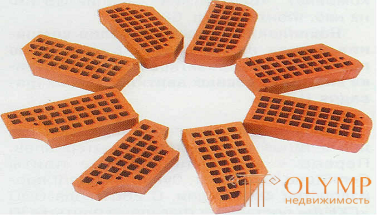
Fig. 15.10 –Big brick
Of course, brick is not the only material used today for the construction of low-rise buildings. The competitors of brick in this market are other block materials, primarily cellular concrete, wood and various frame technologies with the use of mineral insulation.
However, building brick and porous ceramic blocks have several advantages over these materials.
Brick is a well-known, natural, environmentally friendly, “living” material with a centuries-old tradition of use. Unlike wood, it does not require special measures to increase fire resistance, protection from insects and rotting. The small size of the brick allows you to build walls of complex configurations. Thanks to fire resistance, brick walls can adjoin stoves and fireplaces, smoke and ventilation ducts can be laid inside the walls, hidden installation of electrical wiring is facilitated.
Brick walls have high heat capacity and, consequently, high thermal inertia. Even in strong heat in a brick house is cool. The brick has a low water absorption, which distinguishes it from the blocks of cellular concrete. By the way, we must not forget that the experience of using gas and foam concrete in Russia is calculated in years. And data on the behavior of these materials in real conditions have not yet been accumulated. The same applies to the mineral insulation, which is part of the frame structures.
According to the testimony of specialists, until now the search for an alternative to brick was due to the saving of construction time, labor costs and related work. Now there is no need.
RAUF is a modern high-quality brick of a new generation, combining modern technological solutions and centuries-old traditions of using bricks as a building material.
The initial components of a brick (clay, sand, sawdust) are deposited for a certain time in a special storage facility, which allows them to maintain constant properties at the stage of initial preparation. Thanks to the newest equipment, the grinding of the mixture (a mixture of clay, sand and sawdust) is smaller, which allows to improve the quality of the front surface of the brick and reduce the appearance of pitting and microcracks. Each brick has chamfers - special cuts along the edges of the brick, contributing to the improvement of the laying.
Facing ceramic brick, both hollow and solid, is designed for masonry and simultaneous lining of the exterior and interior walls of buildings and structures of any number of floors. In addition, solid brick can be used to perform the basement of buildings, as well as fences, stoves, fireplaces and other architectural and decorative elements.
Decorative facing brick is also used for exterior and interior works, has a different type of embossed or rough surface, allowing to enrich the ceramic masonry with decorative strokes, give it a picturesque expressiveness.
The use of RAUF front ceramic bricks and RAUF ceramic porous block allows building houses with an external wall 51 cm thick in St. Petersburg climate, without resorting to heat insulators, but meeting all existing standards for the thermal protection of residential buildings.
The main component of the RAUF brand product range is ceramic porous stones and facing bricks. Warm ceramics - porous ceramic stones - used in the construction of the outer walls of buildings and structures in the framework of the traditional masonry.
Porous brick (or stone) is lighter than usual, has a low density, low thermal conductivity, excellent thermal insulation properties, softening temperature differences, creates a comfortable microclimate in the house. Lightweight "porizovka" allows you to reduce the load on the foundation. Transport, production and technological costs are significantly reduced, time costs of laying are reduced by 2-2.5 times.
To this day, ceramic brick is one of the most popular building materials. Ceramics continues the associative array: earth, water, air, fire ...
Those who want to make their environment environmentally friendly, as close as possible to nature, for the construction of their country houses choose ceramic bricks.
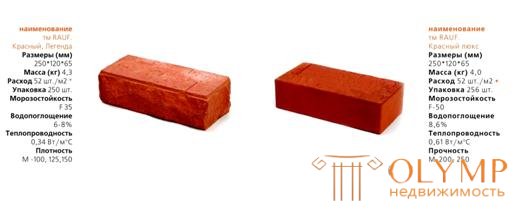
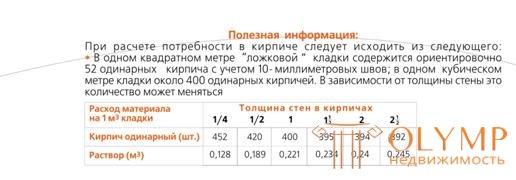
Fig. 15.11. - Ceramic full-face brick
(made in Russia, RAUF)
Silicate brick is made from a mixture of lime (10%) and quartz sand (90%) in autoclaves at a temperature of 170-180 ° C and elevated pressure. The strength characteristics of silicate bricks are the same as those of the ceramic brick, but it is less cold-resistant, water-resistant and more heat-conducting, and also absolutely not fire-resistant. Silicate brick in appearance and properties, it is significantly different from the ceramic. Its natural color is usually white or light gray, although with the addition of pigments to the mixture, almost any shade can be obtained. Silicate brick, as a rule, is denser and stronger than ceramic, but it has a very high water absorption, which limits its scope. It can be used for erecting walls of rooms with low air humidity, as well as as decorative inserts into external walls made of ceramics.
The silicate brick is prepared by semi-dry pressing from a rationally selected mixture of quartz sand, air lime and water. The molded brick is subjected to autoclave treatment - exposure to saturated water vapor at t = 170–200 ° C and vapor pressure of 8–12 atm. As a result of the synthesis of hydrosilicates, a strong artificial stone is formed. Colored silicate brick is obtained by adding weather-resistant alkali-resistant pigments to the mass.

Fig. 15.12. - Ceramic ceramic hollow brick
(production of Estonia, TM TERCA)

Fig. 15.13. - Silicate front full-bodied brick
(made in Finland, TM OPTIROC)
The technical properties of silicate bricks are listed in Table 15.1.
Table 15.1.
Technical properties of silicate brick
Average density, kg / m3 | 1300 |
Compressive strength, MPa | 15-20 |
Frost resistance, cycles | 15-25 |
Maximum application temperature, C | 550 |
Meanwhile, there is a perception that the silicate brick is yesterday, and only non-residential buildings can be built from it. Let us turn to the authoritative experience of our building neighbors from Germany and Finland. In these countries, the consumption of silicate brick does not decrease for several years, and since 1999 it has been increasing. The thermal conductivity of expanded clay bricks is 0.5 W / ms, this value is also comparable to the thermal conductivity of ceramic bricks. The cost of silicate expanded clay bricks is significantly lower than the cost of ceramic bricks. This difference reaches 50%, which, of course, provides significant savings in the construction of wall structures. The established wall thickness remains, the indicator on energy saving of residential buildings does not decrease. In assortment - a facing brick of wide color scale and an impressive brick. These products are also competitive. When used in the lining of silicate bricks, especially color and textured, the lining is perceived as part of the wall construction, which guarantees the building not only a long life, but also originality.
Silicate brick is not recommended for laying foundations and socles of buildings, as well as furnaces and other units operating at high temperatures. When ensuring a dry mode of operation, silicate brick is not inferior in ceramic durability.
Special mention deserves clinker bricks. It is obtained as a result of high-temperature firing of plastic grains of selected quality to full sintering, without inclusions and voids. Due to the peculiarities of raw materials and special technologies, an exceptionally strong, low-porous, color-, wear-, frost-resistant and, as a result, durable product is obtained (despite the fact that there are no chemical additives and dyes in the raw mix). An extensive range of sizes, textures and colors (“fiery” shades of red, shining yellow, white, brown-bluish, “antique” tones, many other options) make it optimal for facing facades and landscape works: paving walkways, car parks and porches to garages, stairs, open terraces, gutters or patios.
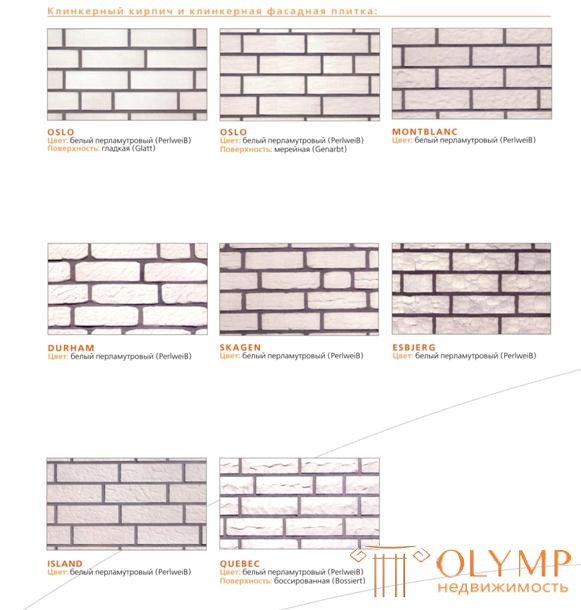
Fig. 15.14. - Clinker brick and clinker facade tiles
(made in Germany, the plant "Roben-Bannbershied")
Ceramic tiles under the brick. In addition to the actual bricks on the market today are facing tiles (from different materials), imitating their appearance. Quite widespread ceramic tile brick. It is relatively cheap, so it is suitable for those who want to save money, but get a house with a rich "appearance", and even from environmentally friendly material. The tile is also used for styling for brick buildings made of other materials (for example, from foam concrete), or for lining buildings whose foundation does not allow the use of bricks. Meanwhile, some experts warn that the tile and the material to which it is attached often have a different coefficient of thermal expansion, because of which the lining can fall off. At the same time, tile decoration is a good option for interior design, especially since the front brick inside the room would take a lot of usable space.
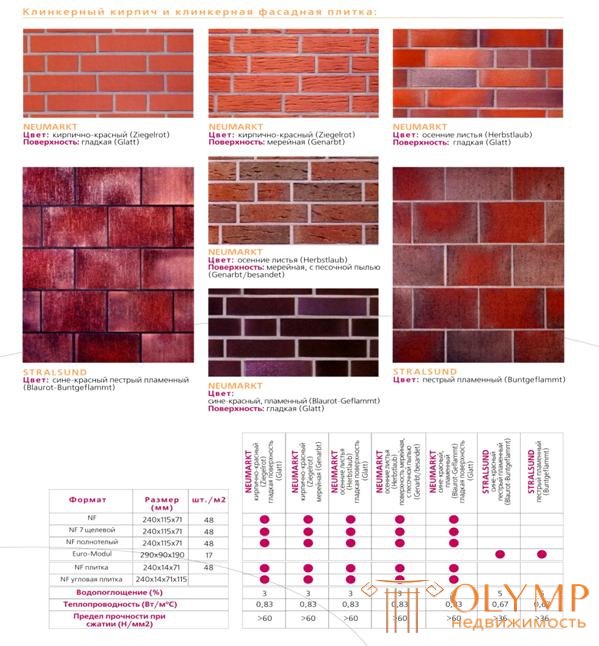
Fig. 15.15. - Clinker brick and clinker facade tiles
(made in Poland, the plant "Roben-Neumarkt")
Технологические линии последнего поколения, на которых производится кирпич с шероховатой или рельефной поверхностью, с поверхностью под старину, полнотелый и колотый, позволяют добиться идеальной геометрии лицевых видов кирпича. Такой кирпич удовлетворяет самым взыскательным требованиям, предъявляемым к качеству облицовочных материалов.
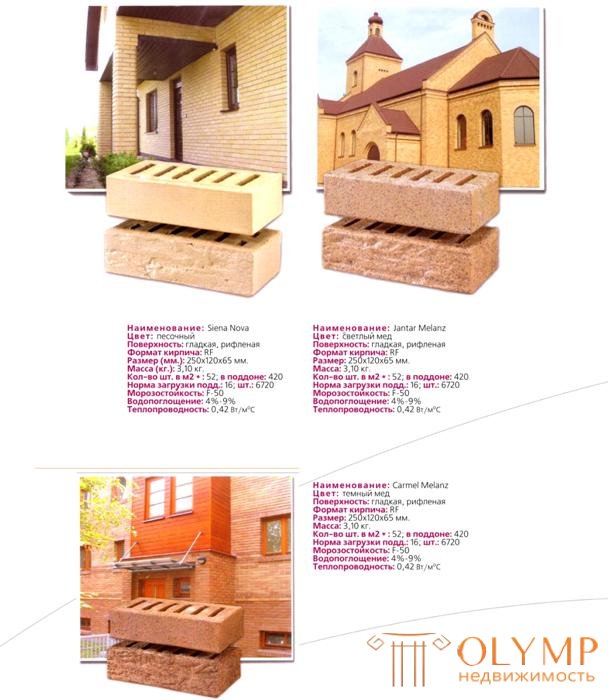
Fig. 15.16. – Рифленый кирпич
(производства Польши, завод «EKO- Klinkier»)
Остановимся на некоторых показателях кирпича. Для определения марки кирпича по прочности в соответствии с ГОСТом кирпич (5 штук от партии) испытывают на сжатие и изгиб (камни только на сжатие) и по полученным данным устанавливают марку кирпича. Стандартом предусмотрено 8 марок кирпича по прочности от М75 до М300 (кгс/см2). Следует отметить, что предел прочности при изгибе составляет не более 20% от предела прочности при сжатии.
Прочность кирпича на сжатие довольно высока. Однако в кладке кирпич работает не только на сжатие, но и на изгиб из-за наличия прослоек раствора и кладки кирпича с перевязкой. Поэтому несущая способность кладки принимается ниже прочности самого кирпича.
Под морозостойкостью в строительстве подразумевают способность материала противостоять периодически повторяющемуся замораживанию и оттаиванию в случае, когда в его порах находится вода.
Совокупное действие увлажнения и периодического замораживания – главнейший природный деструктивный фактор, определяющий долговечность многих строительных материалов в средней полосе России. Поэтому морозостойкость кирпича – очень важный показатель.
Количественной оценкой морозостойкости материала служит число циклов замораживания при -18 +2 С и оттаивания при +20 +2 С в насыщенном водой состоянии до начала структурных нарушений в материале, выражающихся в шелушении поверхности, появлении трещин и, естественно, в снижении его прочности. Нормы на эти показатели устанавливаются ГОСТом на материал.
ГОСТ 530-95 устанавливает следующие марки кирпича: F15, F25, F35 и F50; у лицевого кирпича марки F15 нет. Цифра после буквы F обозначает максимальное число циклов замораживания/оттаивания, которое выдерживает кирпич данной марки без признаков разрушения. Эта цифра показывает потенциальную способность кирпича, оцениваемую в лаборатории в экстремальных условиях. В природе и перепады температур не такие резкие, и насыщение влагой кирпича далеко от предельного. Кроме того, правильные конструктивные решения, касающиеся в основном гидроизоляции, пароизоляции и водоотвода с крыши, могут обеспечить долговечность кирпича в конструкции.
And another very important fact regarding frost resistance. In no case can hollow brick be used for external structures where water can penetrate into its voids (foundations, basement, etc.). In this case, the destruction of bricks can occur very quickly and completely.
The technical documents on ceramic brick and stones adopted a special marking, which indicates the main indicators of the material.
The symbol includes: the name of the type of product: brick or stone, the name of the material: K is ceramic (the symbol C in the silicate brick), features of the product geometry (P - hollow, Y - thickened, G - with a horizontal arrangement of voids), brand by strength : 75-300, mark on frost resistance: F15-F50 and state standard specification number.
In conclusion, once again recall the products of the company RAUF. RAUF assortment includes porous and over-sized large-format ceramic stones. With their help, you can build a high-quality brick house in a short time. The brand RAUF is not only those or other names of ceramic products. This is a customer service system that operates at the highest level. In contrast to European manufacturers offering only facial brick types to the Russian market, the RAUF product range makes it possible to fully equip residential construction
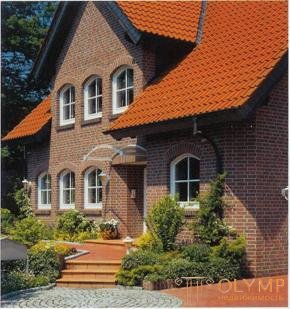
Fig.15.17 - Facade of the house made using materials of the brand RAUF
Что бы оставить комментарий войдите
Комментарии (0)